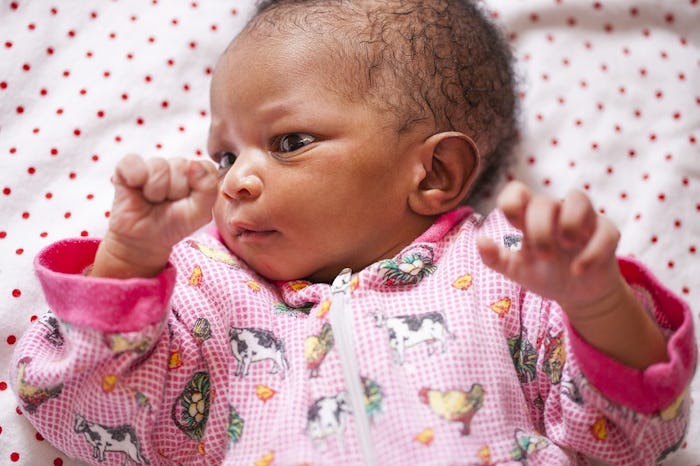Everyone is always looking for a foolproof bedtime routine to get their kids to go to sleep, but you should also be looking for a routine that keeps your child safe come nighttime. There are things you can do at bedtime to reduce the risk of SIDS and I'm thinking that's just as important as reading Goodnight, Moon for the millionth time.
According to the Centers for Disease Control and Prevention, there are 3,500 sudden unexpected infant deaths each year. Of those, 25 percent are caused by accidental suffocation or strangulation in bed, 31 percent are unknown, and 44 percent are related to SIDS. Those are scary numbers, especially considering there is no real cause of SIDS. But the Mayo Clinic noted that research has found several different ways you can reduce your child's risk of SIDS and a lot of them take place in the bedroom. It makes sense since according to the Mayo Clinic, SIDS may be associated with abnormalities in the part of the brain that controls breathing and arousal from sleep. So if you could add some prevention techniques to your child's bedtime routine, why not?
It's always best to stay educated so you don't get yourself too anxious about SIDS and these nine things you can do at bedtime to reduce your child's risk will give you peace of mind. None of them are hard to accomplish or a real sacrifice, so make sure to implement them into your routine so that you and your baby can have a safe, happy night's sleep.
1Turn On A Fan
A well-ventilated room is one of the best things you can do for your baby to help prevent SIDS. According to a study in The Archives of Pediatrics and Adolescent Medicine, using a fan in a baby's room reduced their risk of SIDS by 72 percent and the number increased if there was other unsafe sleeping factors such as a baby sleeping on their side or in a particularly warm room.
2Dress Baby Lightly
Not only does over-bundling a baby to sleep make them uncomfortable, it can also be dangerous. The American Academy of Pediatrics noted that you should dress your baby lightly for sleep and remove layers if you notice sweating, heavy breathing, flushed cheeks, damp hair, rapid breath, or heat rash. Your baby really only needs one extra layer of clothing than you would wear to be comfortable, so skip the fleece pajamas and a swaddle. Choose light cotton pajamas if you're going to swaddle or a warm fleece sleep sack over light PJs.
3Let Them Sleep In Your Room
Sharing a bed isn't recommended as a way to prevent SIDS, but putting your baby in the same room as you is. The American Academy of Pediatrics recommended having your baby room share with you, but keep them in their own bed, bassinet, or crib, as a way to reduce their risk of SIDS.
4Give Them A Pacifier
A 2012 study in the Maternal and Child Health Journal concluded that pacifiers can seriously reduce the risk of SIDS, especially during a baby's last sleep of the day. If you've been on the fence about introducing a pacifier, now might be the time to pick one up. Just remember to keep the pacifier clips and straps out of the crib as they can be a strangulation hazard.
5Put Them To Sleep On Their Back
This one is huge. The National Institute of Child Health and Human Development noted that the safest sleeping position for your baby is to place them on their back, not on their side or tummy.
6Put Them To Bed On A Firm, Safe Sleeping Surface
No couches, water beds, or really soft surfaces. According to the Mayo Clinic, your baby's sleeping surface should be a firm mattress without any thick, fluffy padding or pillows.
7Clean Out Their Crib Of Soft Objects & Blankets
Blankets, toys, pillows, and other objects can obstruct your baby's breathing and keep them from being able to lift their head up to get air. The American Academy of Pediatrics included bumper pads in this ban and noted that your baby's crib should be bare except for a fitted sheet over the mattress.
8Swaddle Your Baby
Swaddling has alarmed people in the past, especially with research concluding that swaddling can be dangerous. However, CNN noted that if your baby isn't rolling over or breaking free of the fabric, it's safe to swaddle and can also eliminate the need for blankets in the crib by keeping your baby comfortable and safe.
9Don't Rely On Products That Claim To Reduce The Risk Of SIDS
There are a lot of products out there like wedges, heart monitors, specialty mattress, and even sleep positioners that claim to prevent SIDS. The National Institute of Child Health and Human Development noted that these products have not been tested for safety and shouldn't be used.
